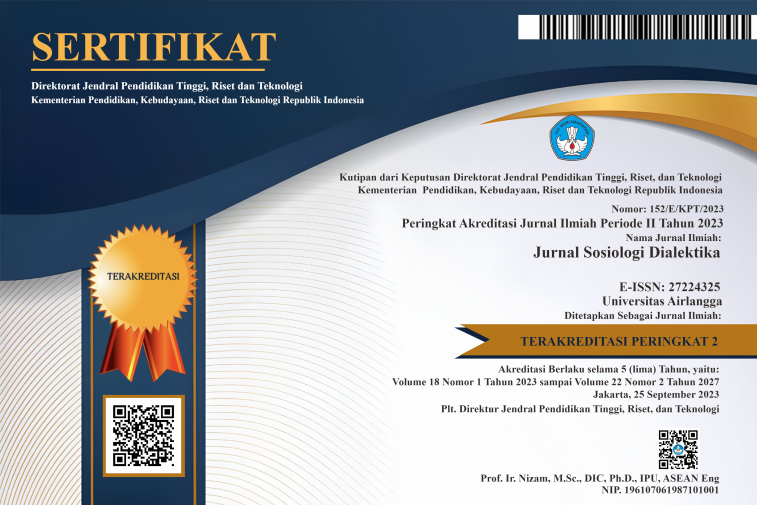Stakeholders engagement in emergency response of flood disasters management in District Ijen, Bondowoso Regency, Indonesia
Downloads
The recurring flash floods in Ijen District, Bondowoso, has caused damage to houses and villages infrastructures. Flood handling requires coordination from multiple stakeholders, social enterprises and Non-Governmental Organizations. This study explores the stakeholders' involvement in the emergency response of flash flood disaster handling in the Ijen District. This study used qualitative and quantitative approaches. The study found that these stakeholders have their own aims and interests. The analysts predict that the power index value is 0.74, while the interest index value is 0.94. These two figures show that both the power and the interests of the stakeholders are very high in dealing with flash flood disasters. Despite the high values, until August 2020, the recovery process had not been completed yet. These findings are important as an evaluation of the emergency response in disaster handling and a warning that it is important to sustain the environmental condition of mountain slopes
Abarquez I & Murshed Z (2004) Field Practitioners' Handbook. Bangkok: Asian Disaster Preparedness Center.
Benito G, Lang M, Barriendos M, Llasat MC, Franc´es F, Ouarda T, Thorndycraft V, Enzel Y, Bardossy A, Coeur D, & Bob´ee B (2004) Use of systematic, palaeoflood and historical data for the improvement of flood risk estimation. Review of Scientific Methods. Natural Hazards 31 (3):623-643. https://doi.org/10.1023/b:nhaz.0000024895.48463.eb.
Bisht DS, Chatterjee C, Kalakoti S, Upadhyay P, Sahoo M, & Panda A (2016) Modeling urban floods and drainage using SWMM and MIKE URBAN: a case study. Natural Hazards 84 (2):749-776. https://doi.org/10.1007/s11069-016-2455-1.
Black AR & Burns JC (2002) Re-assessing the flood risk in Scotland. Science of The Total Environment 294 (1-3):169-184. https://doi.org/10.1016/S0048-9697(02)00062-1.
Bryson JM (2004) What to do when stakeholders matter: Stakeholder identification and analysis techniques. Public Management Review 6 (1):21-53. https://doi.org/10.1080/14719030410001675722.
Donovan K (2010) Doing social volcanology: Exploring the volcanic culture in Indonesia. Area 42 (1):117-126. https://doi.org/10.1111/j.1475-4762.2009.00899.x.
Dottori F, Szewczyk W, Ciscar JC, Zhao F, Alfieri L, Hirabayashi Y, Bianchi A, Mongelli I, Frieler K, Betts RA, & Feyen L (2018) Increased human and economic losses from river flooding with anthropogenic warming. Nature Climatic Change 8 (9):781-786. https://doi.org/10.1038/s41558-018-0257-z.
Feyen L, Dankers R, Bodis K, Salamon P, & Barredo JI (2012) Fluvial flood risk in Europe in present and future climates. Climatic Change 112 (1):47-62. https://doi.org/10.1007/s10584-011-0339-7.
Freeman RE (1984) Strategic Management: A Stakeholder Approach. Boston, MA: Pitman.
Gardner JS & Dekens J (2007) Mountain hazards and the resilience of social-ecological Systems: Lesson learned in India and Canada. Natural Hazards 41 (2):317-336. https://doi.org/10.1007/s11069-006-9038-5.
Geertz C (1963) Agricultural Involution: The Processes of Ecological Change in Indonesia. Berkeley, CA: University of California Press.
Grimble R & Wellard K (1997) Stakeholder methodologies in natural resource management: A review of principles, contexts, experiences and opportunities. Agricultural Systems 55 (2):173-193. https://doi.org/10.1016/S0308-521X(97)00006-1.
Guo H (2017) Big Earth data: a new frontier in Earth and information sciences. Big Earth Data 1 (1-2):4-20. https://doi.org/10.1080/20964471.2017.1403062.
Hu P, Zhang Q, Shi P, Chen B, Fang J, & Sun P (2018) Flood-induced mortality across the globe: Spatiotemporal pattern and influencing factors. Science of The Total Environment 22: 2637-2653. https://doi.org/10.1016/j.scitotenv.2018.06.197.
Hu S, Cheng X, Zhou D, & Zhang H (2017) GIS-based flood risk assessment in suburban areas: A case study of the Fangshan District, Beijing. Natural Hazards 87 (3):1525-1543. https://doi.org/10. 1007/s11069-017-2828-0.
Kirchmeier-Young MC & Zhang X (2020) Human influence has intensified extreme precipitation in North America. Proceedings of the National Academy of Sciences 117 (24):13308-13313. https://www.pnas.org/lookup/suppl/doi:10.1073/pnas.1921628117/-/DCSupplemental.
Kokelaar BP (2002) Setting, chronology and consequences of the eruption of Soufriere Hill Volcano. Montserrat (1995-1999). Geological Society 21: 1-43. https://doi.org/10.1144/GSL.MEM.2002.021.01.02.
Li W, Xu B, & Wen J (2016) Scenario-based community flood risk assessment: A case study of Taining county town, Fujian province, China. Natural Hazards 82 (1):193-208. https://doi.org/10.1007/s11069-016-2187-2.
Morgenthau HJ (1997) Politics among nations: The struggle for power and peace. 6th ed. Singapore.
Prudhomme C, Wilby RL, Crooks S, Kay AL, & Reynard NS (2010) Scenario-neutral approach to climate change impact studies: application to flood risk. Journal of Hydrology 390 (3-4):198-209. https://doi.org/10.1016/j.jhydrol.2010.06.043.
Rodda HJ (2005) The development and application of a flood risk model for the Czech Republic. Natural Hazards 36 (1):207-220. https://doi.org/10.1007/s11069-004-4549-4.
Rustinsyah (2015) Social capital and implementation of subsidized fertilizer programme for small farmers: A case study in rural Java, Indonesia. International Journal of Rural Management 11 (1):25-39. https://doi.org/10.1177/0973005215572730.
Stefanidis S & Stathis D (2013) Assessment of flood hazard based on natural and anthropogenic factors using analytic hierarchy process (AHP). Natural Hazards 68 (2):569-585. https://doi.org/10.1007/s11069-013-0639-5.
Tabari H (2020) Climate change impact on flood and extreme precipitation increases with water availability. Scientific Reports 10 (1):110. https://doi.org/10.1038/s41598-020-70816-2.
UN-ISDR (2011) Global assessment report on disaster risk reduction, the United Nations International Strategy for Disaster Reduction.
Winsemius HC, Aerts JC, Van Beek LP, Bierkens MF, Bouwman A, Jongman B, Kwadijk JC, Ligtvoet W, Lucas PL, van Vuuren DP, & Ward PJ (2016) Global drivers of future river flood risk. Nature Climate Change 6 (4):381-385. https://doi.org/10.1038/NCLIMATE2893.
Wisner B, Blaikie P, Cannon T, & Davis I (2004) At Risk, Natural Hazards, People's Vulnerability and Disaster. New York and London: Routledge.
Zhang Q, Li J, Singh VP, & Xiao M (2013) Spatio-temporal relations between temperature and precipitation regimes: Implications for temperature-induced changes in the hydrological cycle. Global and Planetary Change 111: 57-76. https://doi.org/10.1016/j.gloplacha.2013.08.012.

This work is licensed under a Creative Commons Attribution-NonCommercial-ShareAlike 4.0 International License.
1. Copyright of this journal is possession of Editorial Board and Journal Manager, by the knowledge of author, whilst the moral right of the publication belongs to the author.
2. Legal formal aspect of journal publication accessibility refers to Creative Commons Attribution-NonCommercial-ShareAlike (CC BY-NC-SA), implies that publication can be used for non-commercial purposes in its original form (cannot be modified).
3. Every publications (printed/electronic) are open access for educational purposes, research, and library. Other that the aims mentioned above, editorial board is not responsible for copyright violation.















